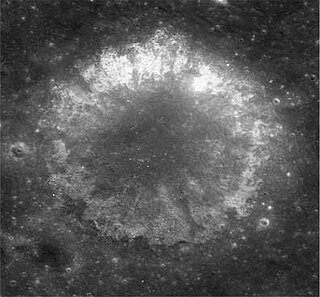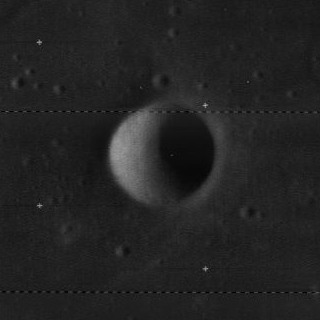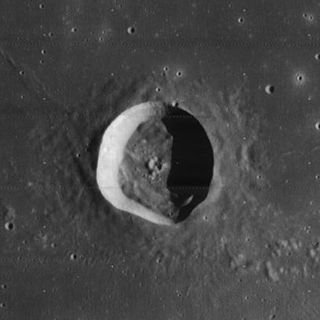
Fracastorius is the lava-flooded remnant of an ancient lunar impact crater located at the southern edge of Mare Nectaris. To the northwest of this formation lies the crater Beaumont, while to the northeast is Rosse.

Artsimovich is a small lunar impact crater located in the western Mare Imbrium of the Earth's Moon. This is a circular crater forming a cup-shaped excavation in the surface of the lunar mare. It is named after Soviet physicist Lev A. Artsimovich. To the east is the crater Diophantus and to the northeast lies Delisle. Less than 20 kilometers to the north-northeast is the tiny Fedorov. This crater was identified as Diophantus A before being named by the International Astronomical Union.

Sampson is a relatively tiny lunar impact crater located near the central part of the Mare Imbrium. It was named after British astronomer Ralph Allan Sampson. To the northeast is the crater Landsteiner and to the southeast lies Timocharis. East of this crater is the Dorsum Grabau, a wrinkle ridge in the mare.

Finsch is a relatively small lunar impact crater in the mid-part of Mare Serenitatis that has been almost completely covered by the mare, forming a ghost crater in the lava plain. It was named after German zoologist Otto Finsch. It is located to the south-southeast of the crater Sarabhai and northeast of Bessel.

Fahrenheit is a tiny lunar impact crater located in the southeast part of the Mare Crisium. This area of the surface is nearly devoid of impact features of interest. To the east are the Dorsa Harker wrinkle ridges, and beyond them is Promontorium Agarum at the edge of the mare. The landing site of the Soviet Luna 24 probe is located about 15 kilometers to the southeast.

Lippershey is a relatively tiny lunar impact crater located in the southeast section of the Mare Nubium. It was named after German-Dutch optician Hans Lippershey. It is a circular, cup-shaped feature surrounded by the lunar mare. Lippershey lies to the northeast of the crater Pitatus.

Asada is a small lunar impact crater located at the northern edge of Mare Fecunditatis, to the northeast of the crater Taruntius. It is a circular crater formation with inner walls that slope down toward a small central floor at the midpoint. Asada was designated Taruntius A prior to being named by the IAU.

Ariadaeus is a small, bowl-shaped lunar impact crater on the western shores of Mare Tranquillitatis. It lies to the north of the crater Dionysius, and to the west-southwest of Arago. The crater is joined along the northeast rim by the slightly smaller Ariadaeus A, and the two form a double-crater. Its diameter is 10.4 km.

Doppelmayer is the remains of a lunar impact crater that lies on the southwest edge of Mare Humorum. It was named after the German mathematician and astronomer Johann Gabriel Doppelmayr. To the south-southeast is another flooded crater designated Lee, and to the southeast is Vitello. Just to the east-northeast of Doppelmayer lies the nearly submerged crater Puiseux.

Flamsteed is a small lunar impact crater located on the Oceanus Procellarum, which is named after British astronomer John Flamsteed. It lies almost due east of the dark-hued Grimaldi, and north-northwest of the flooded Letronne bay on the south edge of the mare.

Archytas is a lunar impact crater that protrudes into the northern edge of Mare Frigoris. To the northwest is the comparably sized crater Timaeus, and the smaller Protagoras lies in the opposite direction to the southeast. Further to the southwest, beyond the opposite edge of the mare, is the dark-floored crater Plato.

Boss is a lunar impact crater that is located along the northeast rim of the Moon's near side. Due to its location, the crater is viewed from the side by observers on the Earth, and its visibility is subject to libration effects.

Calippus is a small lunar impact crater that is located on the eastern edge of the rugged Montes Caucasus mountain range in the northern part of the Moon. It was named after Greek astronomer Callippus of Cyzicus. It lies to the southwest of the crater remnant Alexander, to the northwest of the Mare Serenitatis.

D'Arrest is a lunar impact crater that is located in the lava-flooded region to the west of the Mare Tranquillitatis. It is named after the German astronomer Heinrich Louis d'Arrest. It lies to the southeast of the crater Agrippa and northwest of Delambre. Just to the northeast are the small, bowl-shaped craters De Morgan and Cayley.

Damoiseau is a lunar impact crater that is located just to the west of the Oceanus Procellarum, in the western part of the Moon's near side. It lies due east of the prominent crater Grimaldi, a walled plain with a distinctive dark floor. Due south of Damoiseau is the crater Sirsalis.

Yangel' is a small lunar impact crater that is located in the irregular terrain to the north of the Mare Vaporum. Its diameter is 8 km. It was named after Soviet rocketry scientist Mikhail Kuzmich Yangel' in 1973. This crater was formerly designated Manilius F.

Crozier is a lunar impact crater that is located on the southwest edge of Mare Fecunditatis, a lunar mare in the eastern part of the Moon's near side. It lies to the east-northeast of the prominent crater Colombo, and southeast of the small crater Bellot.

Eimmart is a lunar impact crater that is located near the east-northeastern limb of the Moon, to the northeast of the Mare Crisium. The northern and eastern outer rim of this crater borders on the narrow Mare Anguis. To the northwest of Eimmart are the smaller crater Delmotte and the prominent Cleomedes.

Fourier is a lunar impact crater that is located in the southwestern part of the Moon's near side, just to the southeast of the crater Vieta. To the northeast is the Mare Humorum. The rim of this crater is roughly circular, but appears oval when viewed from the Earth due to foreshortening.

Mons La Hire is a solitary lunar mountain in the western Mare Imbrium. It is located to the northeast of the crater Euler, and to the west-northwest of Lambert.


























